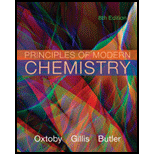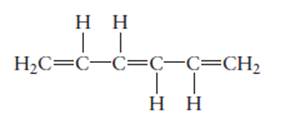
Concept explainers
(a)
Interpretation:
The name of the following molecule should be determined.

Concept Introduction:
Compounds consist of carbon and hydrogen is known as hydrocarbons.
Rules of naming
- First choose the longest continuous chain of carbon atoms having double bond known as parent chain.
- The numbering of parent chain should be done in a way that the double bond and substituents get the lowest number.
- The root name of the carbon chain is same as in case of
alkanes , but “−ane” ending is replaced by “−ene” - The appropriate name should be given to every alkyl group and denote its position on the parent chain with the number.
- The alkyl groups are written in alphabetical order.
(b)
Interpretation:
The name of the following molecule should be determined.

Concept Introduction:
Compounds consist of carbon and hydrogen is known as hydrocarbons. Unsaturated hydrocarbon having double bond is known as alkene having general molecular formula
Rules of naming alkenes are:
- First choose the longest continuous chain of carbon atoms having double bond known as parent chain.
- The numbering of parent chain should be done in a way that the double bond and substituents get the lowest number.
- The root name of the carbon chain is same as in case of alkanes, but “−ane” ending is replaced by “−ene”
- The appropriate name should be given to every alkyl group and denote its position on the parent chain with the number.
- The alkyl groups are written in alphabetical order.
(c)
Interpretation:
The name of the following molecule should be determined.

Concept Introduction:
Compounds consist of carbon and hydrogen is known as hydrocarbons. Unsaturated hydrocarbon having double bond is known as alkene having general molecular formula
Rules of naming alkenes are:
- First choose the longest continuous chain of carbon atoms having double bond known as parent chain.
- The numbering of parent chain should be done in a way that the double bond and substituents get the lowest number.
- The root name of the carbon chain is same as in case of alkanes, but “−ane” ending is replaced by “−ene”
- The appropriate name should be given to every alkyl group and denote its position on the parent chain with the number.
- The alkyl groups are written in alphabetical order.
(d)
Interpretation:
The name of the following molecule should be determined.

Concept Introduction:
Compounds consist of carbon and hydrogen is known as hydrocarbons. Unsaturated hydrocarbon having double bond is known as alkene having general molecular formula
Rules of naming alkynes are:
1. First choose the longest continuous chain of carbon atoms having triple bond known as parent chain.
2. The numbering of parent chain should be done in a way that the triple bond and substituents get the lowest number.
3. The root name of the carbon chain is same as in case of alkanes, but “−ane” ending is replaced by “−yne”
4. The appropriate name should be given to every alkyl group and denote its position on the parent chain with the number.
5. The alkyl groups are written in alphabetical order.
Want to see the full answer?
Check out a sample textbook solution
Chapter 7 Solutions
Bundle: Principles of Modern Chemistry, 8th + OWLv2, 1 term (6 months) Printed Access Card
- Draw a Lewis dot structure for C2H4Oarrow_forward3.3 Consider the variation of molar Gibbs energy with pressure. 3.3.1 Write the mathematical expression for the slope of graph of molar Gibbs energy against 3.3.2 pressure at constant temperature. Draw in same diagram graphs showing variation with pressure of molar Gibbs energies of a substance in gaseous, liquid and solid forms at constant temperature. 3.3.3 Indicate in your graphs melting and boiling points. 3.3.4 Indicate for the respective phases the regions of relative stability.arrow_forwardIn 2-chloropropane, the signal for the H on the C next to Cl should be split into how many peaks?arrow_forward
- 4.4 Consider as perfect gas 3.0 mol of argon gas to which 229 J of energy is supplied as heat at constant pressure and temperature increases by 2.55 K. Calculate 4.4.1 constant pressure molar heat capacity. 4.4.2 constant volume molar heat capacity.arrow_forward3.2 32 Consider calibrating a calorimeter and measuring heat transferred. A sample of compound was burned in a calorimeter and a temperature change of 3.33°C recorded. When a 1.23 A current from a 12.0 V source was passed through a heater in the same calorimeter for 156 s, the temperature changed of 4.47°C was recorded. 3.2.1 Calculate the heat supplied by the heater. 3.2.2 Calculate the calorimeter constant. 3.2.3 Calculate the heat released by the combustion reaction.arrow_forward-.1 Consider the standard enthalpy of formation of gaseous water at 25°C as -241.82 kJ/mol and calculate the standard enthalpy of formation of gaseous water at 100°C.arrow_forward
- 3.5 Complete the following sentences to make correct scientific meaning. 3.5.1 The entropy of a perfect gas. 3.5.2 when it expands isothermally. The change in entropy of a substance accompanying a change of state at its transition 3.5.3 temperature is calculated from its of transition. The increase in entropy when a substance is heated is calculated from itsarrow_forward3.4 Consider the internal energy of a substance 3.4.1 Draw a graph showing the variation of internal energy with temperature at constant volume 3.4.2 Write the mathematical expression for the slope in your graph in 3.4.1arrow_forwardFor a system, the excited state decays to the ground state with a half-life of 15 ns, emitting radiation of 6000 Å. Determine the Einstein coefficients for stimulated absorption and spontaneous emission and the dipole moment of the transition. Data: epsilon 0 = 8.85419x10-12 C2m-1J-1arrow_forward
- Problem a. The following compounds have the same molecular formula as benzene. How many monobrominated products could each form? 1. HC =CC=CCH2CH3 2. CH2=CHC = CCH=CH₂ b. How many dibrominated products could each of the preceding compounds form? (Do not include stereoisomers.)arrow_forwardDon't used Ai solutionarrow_forward4.3 Explain the following terms: 4.3.1 Normal boiling point. 4.3.2 Cooling curve. 4.3.3 Congruent melting. 4.3.4 Ideal solution. 4.3.5 Phase diagram of a pure substance.arrow_forward
 World of Chemistry, 3rd editionChemistryISBN:9781133109655Author:Steven S. Zumdahl, Susan L. Zumdahl, Donald J. DeCostePublisher:Brooks / Cole / Cengage Learning
World of Chemistry, 3rd editionChemistryISBN:9781133109655Author:Steven S. Zumdahl, Susan L. Zumdahl, Donald J. DeCostePublisher:Brooks / Cole / Cengage Learning
 Introductory Chemistry: A FoundationChemistryISBN:9781337399425Author:Steven S. Zumdahl, Donald J. DeCostePublisher:Cengage Learning
Introductory Chemistry: A FoundationChemistryISBN:9781337399425Author:Steven S. Zumdahl, Donald J. DeCostePublisher:Cengage Learning- Chemistry: Matter and ChangeChemistryISBN:9780078746376Author:Dinah Zike, Laurel Dingrando, Nicholas Hainen, Cheryl WistromPublisher:Glencoe/McGraw-Hill School Pub Co
 Introductory Chemistry: An Active Learning Approa...ChemistryISBN:9781305079250Author:Mark S. Cracolice, Ed PetersPublisher:Cengage Learning
Introductory Chemistry: An Active Learning Approa...ChemistryISBN:9781305079250Author:Mark S. Cracolice, Ed PetersPublisher:Cengage Learning Chemistry by OpenStax (2015-05-04)ChemistryISBN:9781938168390Author:Klaus Theopold, Richard H Langley, Paul Flowers, William R. Robinson, Mark BlaserPublisher:OpenStax
Chemistry by OpenStax (2015-05-04)ChemistryISBN:9781938168390Author:Klaus Theopold, Richard H Langley, Paul Flowers, William R. Robinson, Mark BlaserPublisher:OpenStax





